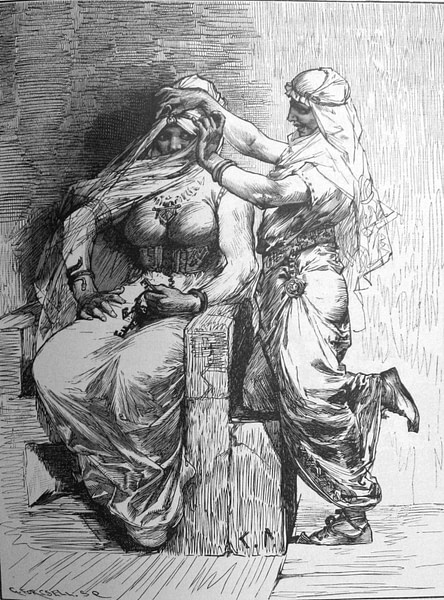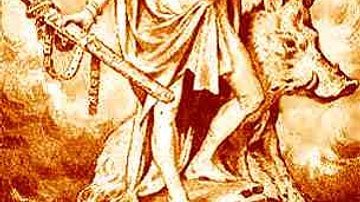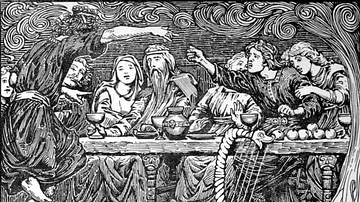
Freyja (Old Norse for 'Lady', 'Woman', or 'Mistress') is the best-known and most important goddess in Norse mythology. Beautiful and many-functioned, she features heavily as a fertility goddess stemming from her place in the Vanir family of the gods (the other and main one is the Æsir family) along with her twin brother Freyr and father Njord, and stars in many myths recorded in Old Norse literature as lover or object of lust. She lives in Fólkvangr ('Field of the People'), rides a carriage drawn by cats, and is connected not just with love and lust but also with wealth, magic, as well as hand-picking half of all fallen warriors on battlefields to go into Odin's hall of Valhalla – the other half being selected by Odin himself. She likely played an important role in old Scandinavian religion.
Family
Freyja is part of the Vanir family of the gods who handle all things fertility-related, including harvests (her brother Freyr); wind, sea, and wealth (her father Njord); and her own expertise regarding love, lust, and wealth, too. Her mother appears to have been giant-daughter and wife of Njord, Skadi, and while originally Freyja may have been paired in a brother-sister married couple with Freyr, Icelandic mythographer Snorri Sturluson (1179-1241 CE) – our most comprehensive source when it comes to Norse mythology – has her down as wife of Ódr, who she has two daughters with; Hnoss and Gersimi (Gylfaginning, 35). These names both mean something along the lines of 'preciousness' or 'treasure' and were possibly used in later poetry as manifestations of Freyja herself.
Ódr is said to have gone traipsing around on long journeys, inexplicably leaving Freyja behind, who would then search for him while weeping golden tears; this tale dates back to at least as early as the 10th century CE. He and Odin are commonly thought to have originally been one and the same person, with Ódr functioning as a shortened form of Odin.
Attributes
One of Freyja's attributes has already been mentioned: her cat-drawn carriage with which she zooms around the Norse mythological cosmos. Another is a garment - a coat, cloak or dress-like thing - made out of falcon feathers. Possibly, the boar Hildisvíni should also be counted among Freyja's attributes; the Hyndluljóð poem has her riding said boar, and a boar connection, in general, is made more plausible by the fact that her brother Freyr is also associated with a boar, in his case named Gullinborsti. Sýr, another name of Freyja's, is sometimes translated as 'sow', too, but it also might mean 'to protect', 'to shield,' in which case it would negate this third boar link. Germanic mythological powerhouse H. R. Ellis Davidson adds another animal: "Horses were certainly associated with the fertility pair Freyr and Freyja, and said to be kept in their holy places" (104). Her last - but not least - attribute is the necklace Brísingamen.
Freyja's many roles
The baseline of Freyja's various functions comes from her role as fertility goddess as per her Vanir descent. Specifically, her other name Horn (Hǫrn, or Härn) probably comes from Old Norse horr, which means flax or linen. This was an important product which began being cultivated early on in Scandinavia and was thought to ward off evil and give fertility to humankind. Flax manufacture was a female affair, and as bridal dresses were made of linen, Freyja became a sort of defender of love and weddings, too. Another one of her names, Gefn, is Old Norse for 'giver', bringing to mind a role as a goddess of plenty.
The handed-down mythology emphasises Freyja's role in all things related to sexuality (apart from childbirth, with which she seems unconcerned). For one, she often features as an irresistible object of lust, mainly in the eyes of the giants. The giant Thrym, for example, is only cool with returning the hammer he has stolen from Thor if he gets Freyja for his own. Besides her being the 'price' of many things - which the other gods try to avoid paying, as such - other myths reinforce Freyja's supposed free and considerable sexuality. Although Loki in the Lokasenna poem badmouths everyone around him and accuses all the goddesses of various sexual acts, Freyja is reprimanded by Loki as follows:
Be silent, Freyja! | for fully I know thee,
Sinless thou art not thyself;
Of the gods and elves | who are gathered here,
Each one as thy lover has lain. (30)
She also consents to sleep with four dwarves in turn in order for them to hand over the Brísingamen to her and is accused in the Hyndluljóð poem of being the hero Óttar's lover. Presumably, then, early Scandinavians looked to Freyja in matters of love and lust.
To make things even better, Freyja is also a goddess of wealth, as attested to by the many poetic references that link her to treasure. Her tears are said to be made of gold, even being synonymous with the material:
Gold is called Freyja's Tears (…). So sang Skúli Thorsteinsson:
Many a fearless swordsman
Received the Tears of Freyja.
(Skáldskaparmál, 37)
The fact that Freyja's daughters' names Hnoss and Gersimi mean 'preciousness' or 'treasure' could arguably be seen as the "product of poetic convention in which Freyja was recognized as the source of treasure: perhaps as the weeper of golden tears, perhaps as a goddess ruling over wealth" (Billington & Green, 61).
Her connection with magic is also well-known, and Snorri Sturluson relays how it was Freyja who first taught the shamanistic magic called seiðr to the Æsir. Finally, the way Freyja chooses slain warriors to be on her as opposed to Odin's team carries her into more ferocious spheres, functioning as a goddess of death and perhaps even battle itself. Which god selects you seems to boil down to social or personal status, or perhaps comes from the fact that both the Vanir and the Æsir needed someone to fulfil this role on the battlefield. This link between Freyja and Odin, as well as Odin's own strong proficiency with magic, helps illustrate how Odin and Ódr, Freyja's husband, could plausibly have originally been the same person.
myths involving Freyja
As evidenced above, there are plenty of myths recorded in the Old Norse sources that are keen to dive into the subject of Freyja. The Hyndluljóð poem emphasises she was more than just a pretty face; in it, Freyja visits wise-woman Hyndla asking her to unravel the hero Óttar's ancestry, soaking up this knowledge. However, in the Þrymskviða (the 'Lay of Thrym', a poem possibly composed in the 12th or 13th century CE and found in the Poetic Edda), her desirability is once again a core theme. The story tells of Thor's hammer being stolen by the giant Thrym, who will not return the hammer unless he gets his hands on Freyja. Freyja refuses to tag along, however, giving up the Brísingamen to help Thor disguise himself as her. After almost giving things away because Thor gorged himself to such an extent at the wedding banquet so as to raise suspicion - his burning eyes not helping either - Loki luckily smooth-talks his way out of it and ensures they get the hammer back. For good measure, Thor kills Thrym and a bunch of other giants on his way out.
As for other giant-related myths, the giant Hrungnir boasts he would bodily move Valhalla into Jotunheimen (the realm of the giants), sink Asgard (the realm of the gods), and kill all the gods except for Freyja and Sif, who he will take home with him (Skáldskaparmál, 17). In the tale of the Giant Master Builder, a giant offers to build walls around Asgard as long as he gets Freyja, the sun and the moon. Regarding her necklace Brísingamen, which is assigned to Freyja by Late Old Norse sources (13th and 14th centuries CE), the most famous myth concerns its theft (most commonly by Loki) but is preserved in such a fragmentary and tricky way that it is now rather hard to come up with one comprehensive story. The most detailed version is also the youngest and thus not the pinnacle of reliability: the Sǫrla Þáttr, which survives in the 14th century CE Flateyjarbók, describes how Freyja sleeps with four dwarves to get the Brísingamen, and how Odin then forces Loki to steal the necklace from her. Loki enters her bedroom as a fly, stings her so she moves her hand off of the necklace, and grabs it. By contrast, Snorri Sturluson has Loki and Heimdall fighting each other over the necklace (Skáldskaparmál, 8).
Cult of Freyja
As a fertility goddess, Freyja would have taken up a central role in old Scandinavian religion, playing a part in the circle of life. J. P. Schjødt explains her special position:
Freyja is one of the few individual goddesses who has had a major role in the more official religious cult (whereas many female deities seen as collectives played a part in both myth and ritual). She incorporates many traits that can be found in fertility goddesses all over the world, among whom is a clear connection also to death. (Brink & Price, 221)
The Old Norse sources do not specifically detail the existence of a cult of Freyja per se, but the large number of place-names in Sweden and Norway related to her name, such as Frøihov (from Freyjuhof, 'Freyja's temple') and Frǫvi (from Freyjuvé, 'Freyja's shrine'), show clear worship, perhaps even pointing to a public cult as opposed to the domestic cult one would expect of a goddess of love. It is clear that the people of Iceland on the cusp of conversion to Christianity around the year 1000 CE still had Freyja clearly on their mind. The Íslendingabók states that Hjalti Skeggjason, a supporter of Christianity, was outlawed for blasphemy after calling Freyja a bitch (in this case a female dog, but taken to mean he wanted to call her a whore) at the Althing parliament. She was obviously still important enough for people to not successfully get away with these sorts of things.










